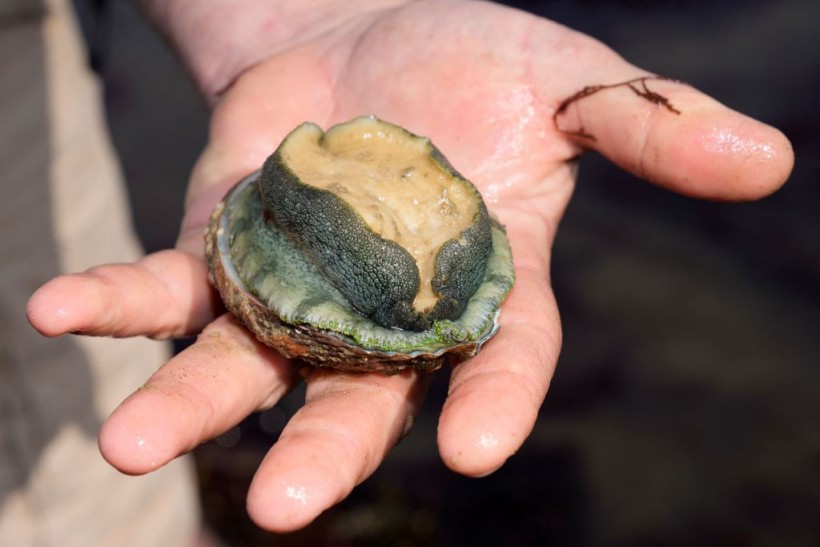Ocean acidification is a serious threat to many marine organisms, especially those that rely on calcium carbonate shells or skeletons, such as corals, oysters, and abalone.
As the ocean becomes more acidic due to increased carbon dioxide emissions, these organisms have a harder time building and maintaining their structures, which can affect their growth, survival, and reproduction.
However, a new study from the University of California, Davis, has found that some red abalone mothers have a remarkable way of helping their offspring cope with ocean acidification.
They give them a boost of energy when they are born, in the form of yolk lipids, which are fatty molecules that provide fuel for the developing embryos.
This extra energy helps the baby abalone resist the negative effects of ocean acidification and increases their chances of survival.
The study: comparing wild and farmed abalone
 (Photo : DAMIEN MEYER/AFP via Getty Images)
(Photo : DAMIEN MEYER/AFP via Getty Images)

The study, published in the journal Proceedings of the National Academy of Sciences, compared the effects of ocean acidification on wild and farmed red abalone to identify traits that could help sustainably produce California's declining abalone species in the future.
Red abalone are a highly valued seafood delicacy and an important part of the coastal ecosystem, but they have been severely overharvested and impacted by disease, predation, and climate change.
The researchers simulated captive aquaculture conditions under ocean acidification and found that abalone sourced from a strong upwelling region along the Mendocino coast were tolerant of ongoing ocean acidification, while nearly half of captive-raised abalone sourced from a Southern California aquaculture facility died under the same conditions.
The team repeated this experiment in a second generation of abalone descended from the first experimental group and observed a similar outcome.
They discovered that this tolerance was largely due to a burst of energy provided to offspring from abalone mothers in the form of yolk lipids.
Captive-sourced animals did not provide the same additional energy to their offspring.
The study's lead author, Dan Swezey, explained that the wild abalone had evolved to give their babies a better start in life by providing them with more energy, which made them more resilient to acidification stress.
He added that the amount of energy the mother gave was correlated with the offspring's tolerance.
Also Read: Scientists Use 'Love Potion' to Help Endangered White Abalone Snail Reproduce
The implications: slower growth but higher survival
The study also found that farmed abalone grew about three times faster than their wild-sourced North Coast counterparts.
While growing abalone quickly makes sense from a market standpoint, the researchers found that the fast-growing abalone were also the most susceptible to dying from ocean acidification.
Swezey pointed out the trade-off between growth and survival, saying that the animals that were most tolerant of ocean acidification grew really slowly.
He noted that selecting for fast-growing abalone could inadvertently make them more vulnerable to ocean acidification.
The researchers suggested that aquaculture managers and conservationists could use the information from this study to select for abalone that have higher yolk lipid content and slower growth rates, which could make them more resilient to ocean acidification and other environmental stressors.
They also recommended that abalone hatcheries and farms monitor and adjust the water chemistry to reduce the acidity and increase the availability of carbonate ions, which are essential for shell formation.
The study is part of a larger project funded by the California Ocean Protection Council and the California Sea Grant to understand the effects of ocean acidification on California's abalone species and develop strategies to mitigate them.
The project also involves researchers from the UC Davis Coastal and Marine Sciences Institute, the UC Davis Department of Animal Science, the UC Davis Department of Environmental Toxicology, the UC Davis Department of Earth and Planetary Sciences, the UC Davis Department of Statistics, the UC Davis Genome Center, the UC Santa Cruz Institute of Marine Sciences, and the California Department of Fish and Wildlife.
The researchers hoped that their findings will help preserve and restore the red abalone population, which has been a cultural and economic resource for generations of Californians.
Swezey expressed his admiration for the red abalone, calling them iconic animals that represent the beauty and bounty of the coast. He said that he and his team wanted to do everything they could to ensure their future.
Related article: Rare Shellfish: Restoring Abalone to California
© 2024 NatureWorldNews.com All rights reserved. Do not reproduce without permission.





